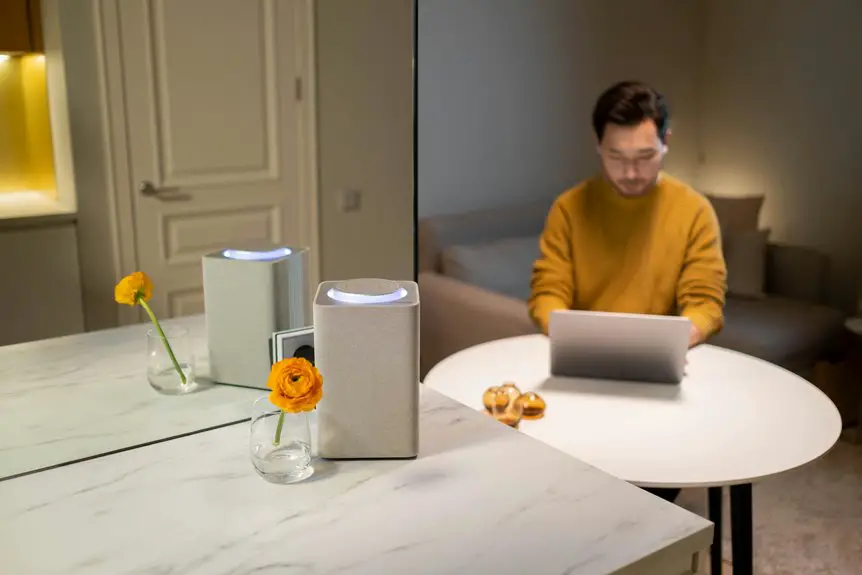Deciding on separate monitors for each room depends on your daily activities and needs. If you multitask frequently or engage in specific tasks like gaming or work, multiple monitors can boost productivity and streamline your workflow. However, consider the costs, space limitations, and energy usage. A central monitor might suffice for lighter use. Balancing functionality and aesthetics is key, and there’s more to explore about optimizing your setup for comfort and efficiency.
Table of Contents
Key Takeaways
- Assess daily activities in each room to determine if a separate monitor is necessary for productivity and convenience.
- Consider the benefits of multitasking and streamlined workflows that multiple monitors can offer for specific tasks.
- Evaluate the space available and budget constraints before investing in additional monitors for each room.
- Explore alternatives like a single large monitor, portable displays, or smart TVs that could serve multiple purposes.
- Personal preferences and comfort should guide your decision on monitor setups to enhance usability across different areas.
Assessing Your Lifestyle and Needs
How do you use technology in your daily life? Think about your routine and how different spaces serve various functions.
If you enjoy working from home, a dedicated monitor in your office might boost productivity. In contrast, if you primarily watch movies in your living room, a larger screen there could enhance your viewing experience.
Consider the activities you engage in each room. Do you game in your bedroom or scroll through emails in the kitchen? Evaluating how you interact with technology helps determine whether separate monitors are necessary.
Evaluate how you use technology in different spaces to decide if multiple monitors suit your lifestyle.
Additionally, assess how often you switch between tasks and locations. This insight will guide your decision on whether investing in multiple monitors aligns with your lifestyle and needs.
Benefits of Having Multiple Monitors
Having multiple monitors can greatly boost your productivity, allowing you to multitask more efficiently.
You can easily manage various projects or tasks side by side without losing focus.
Plus, it enhances your entertainment experience, making movies and gaming even more immersive.
Enhanced Productivity Levels
When you use separate monitors for each room, you’ll likely find that your productivity levels soar.
With dedicated screens, you can streamline your workflow and tackle tasks more efficiently.
Imagine:
- A spacious workspace where you can easily view multiple documents side by side.
- Instant access to real-time data, helping you make quicker decisions.
- Seamless multitasking, allowing you to juggle video calls, emails, and research without missing a beat.
- A clutter-free environment that reduces distractions, keeping you focused on the task at hand.
Improved Entertainment Experience
While you might think a single screen suffices for entertainment, using separate monitors transforms your viewing experience into something truly immersive. Imagine streaming your favorite series in one room while gaming in another, or having a dedicated space for movie nights with friends. With multiple monitors, you can create unique environments tailored to your mood and activities.
| Benefits | Experience |
|---|---|
| Enhanced visuals | Stunning graphics |
| Multi-tasking ease | Switch between activities |
| Customized setups | Tailored to your needs |
Having monitors in multiple rooms lets you enjoy a seamless shift from work to play, ensuring every moment is as engaging as possible. So, why settle for less? Embrace the upgrade!
Drawbacks of Separate Monitors in Each Room
While having separate monitors in each room sounds convenient, it can lead to increased costs that might strain your budget.
You also have to take into account space constraints, as not every room can easily accommodate additional screens.
Balancing functionality with practical limitations is essential when setting up your home or office.
Increased Costs
Although separate monitors in each room can enhance your viewing experience, they also come with noticeably increased costs.
You might find yourself facing some hefty expenses that can impact your budget considerably. Consider these financial factors:
- Multiple Monitor Purchases: Buying several high-quality monitors can add up quickly.
- Installation Fees: Professional installation for ideal setup can be an added expense.
- Increased Energy Bills: Running multiple devices will inevitably raise your electricity costs.
- Maintenance and Repair: Each monitor will require upkeep, leading to potential repair bills over time.
Ultimately, while enjoying a personalized viewing experience is appealing, the financial implications can be a major drawback you can’t overlook.
Space Constraints
The financial burden of setting up separate monitors in each room isn’t the only concern; space constraints can also pose significant challenges.
You might find that your rooms simply don’t have enough space for multiple monitors, especially in smaller homes or apartments. Each monitor requires not just physical room but also an appropriate setup—a desk, power outlets, and cable management.
Cluttering your space with monitors can create an uncomfortable environment, making it difficult to move around freely. Additionally, if you’re trying to maintain an aesthetic look in your home, multiple screens can clash with your decor, leading to a disjointed feel.
It’s essential to weigh these spatial limitations before committing to multiple monitors.
Ideal Scenarios for a Central Monitor
When you want to streamline operations across multiple rooms, a central monitor can be a game changer. It gives you a unified view of everything happening in your home, making it easier to manage various tasks.
Here are some ideal scenarios where a central monitor shines:
- Home office management: Keep track of meetings, deadlines, and tasks in one spot.
- Family coordination: Display schedules, reminders, and lists for everyone to see.
- Entertainment control: Manage music, movies, and gaming from a single interface.
- Security monitoring: View camera feeds and alerts without switching devices.
With a central monitor, you’ll enhance efficiency and communication, ensuring your home runs smoothly.
Smart Home Integration and Connectivity
As you integrate smart home devices, connectivity becomes essential for maximizing their potential. A reliable network guarantees all your devices communicate effectively, creating a seamless experience.
You’ll want to invest in a strong Wi-Fi router or mesh system to cover your entire home. Consider how each room’s layout affects signal strength; dead zones can disrupt your smart devices’ functionality.
Utilizing protocols like Zigbee or Z-Wave can enhance connectivity among devices, especially if you’re mixing brands. Central hubs can simplify control, letting you manage multiple devices from one app.
Enhance device connectivity with Zigbee or Z-Wave, and streamline control through a central hub for effortless management.
With the right setup, your smart home can respond intuitively to your needs, whether you’re adjusting your thermostat or dimming lights. Strong connectivity is key to revealing the full potential of your smart home.
Budget Considerations and Cost Analysis
Budgeting for separate monitors in each room requires careful planning and analysis of your overall costs.
Before diving in, consider these key factors:
- Monitor prices: High-quality monitors can range widely, so research options that fit your budget.
- Installation costs: Factor in any expenses for mounting brackets or professional installation.
- Wiring and connectivity: Don’t forget about the cost of cables and potential upgrades to your home network.
- Long-term expenses: Think about energy consumption and maintenance over time.
Making the Final Decision: What Works for You
Deciding on separate monitors for each room can feel overwhelming, especially with so many options and factors to contemplate. To make the best choice, consider your lifestyle, space, and budget. Ask yourself how often you’ll use each monitor and whether portability matters.
Here’s a simple table to help guide your decision:
| Factors | Yes | No |
|---|---|---|
| Need for portability | [ ] | [ ] |
| Multiple users | [ ] | [ ] |
| Specific functions | [ ] | [ ] |
| Limited space | [ ] | [ ] |
This will help clarify what works for you. Ultimately, choose a setup that enhances your daily life without complicating it.
Frequently Asked Questions
Can I Use a Single Monitor for Both Work and Entertainment?
Yes, you can definitely use a single monitor for both work and entertainment. Just guarantee it has the right resolution and size for your tasks, and make adjustments to suit your preferences during each activity.
What Types of Monitors Are Best for Different Rooms?
For different rooms, consider size and purpose. A larger monitor’s great for entertainment, while a smaller one’s ideal for tasks. Look for adjustable features and resolutions that suit your activities in each space.
How Do I Choose the Right Size Monitor for My Space?
To choose the right size monitor for your space, measure the distance from your seating area. Generally, the larger the screen, the farther you should sit. Consider your room’s layout and personal viewing preferences.
Are There Portable Monitor Options for Temporary Setups?
Portable monitors provide perfect solutions for temporary setups. You’ll find various lightweight, versatile options that easily connect to your devices. Whether you’re working, gaming, or streaming, these monitors enhance every experience with convenience and clarity.
What Are the Best Wireless Options for Connecting Monitors?
For wireless monitor connections, consider options like Chromecast, Apple AirPlay, or Miracast. These technologies let you stream content seamlessly, giving you flexibility without the hassle of cables cluttering your workspace or living area.




